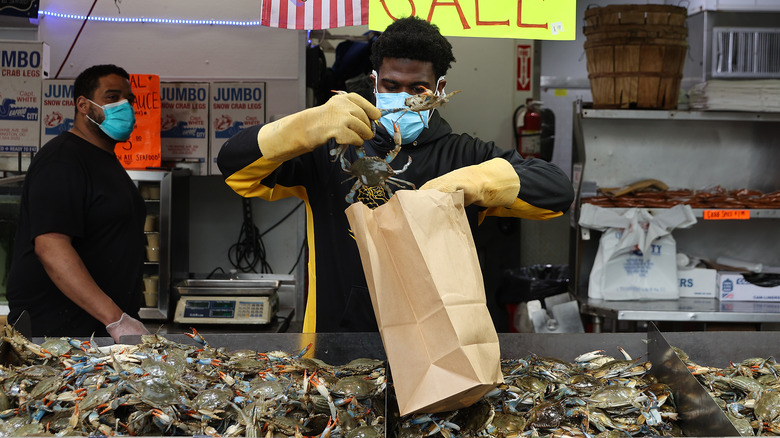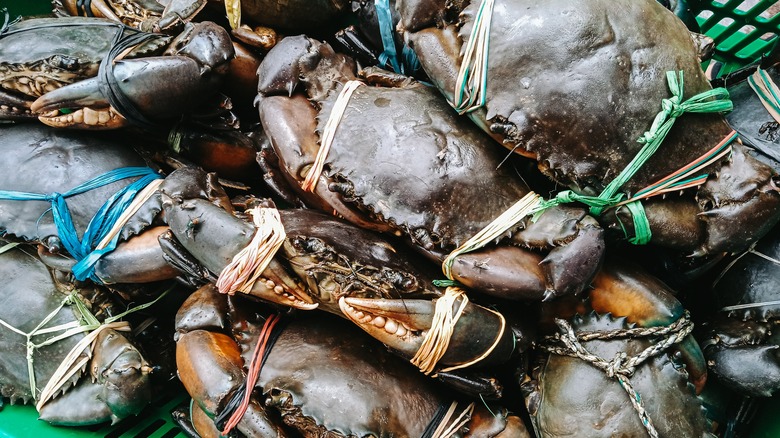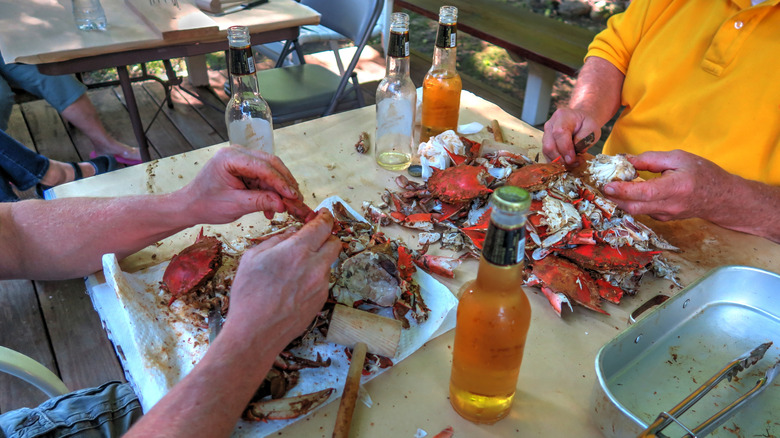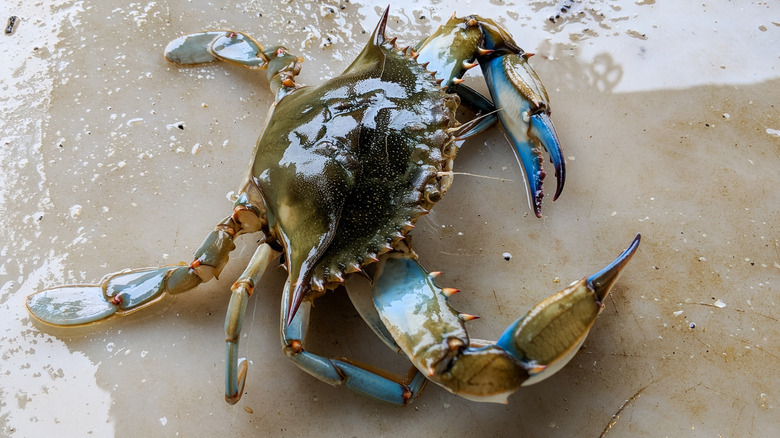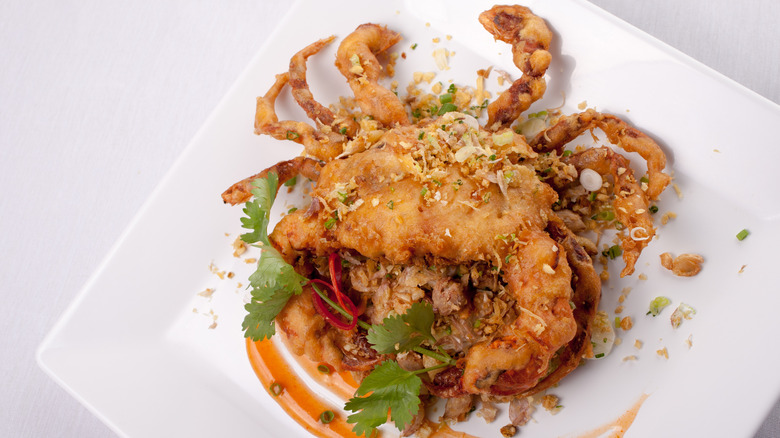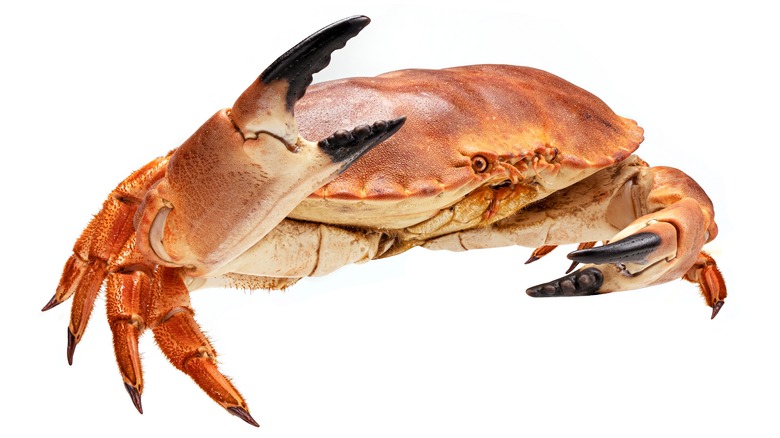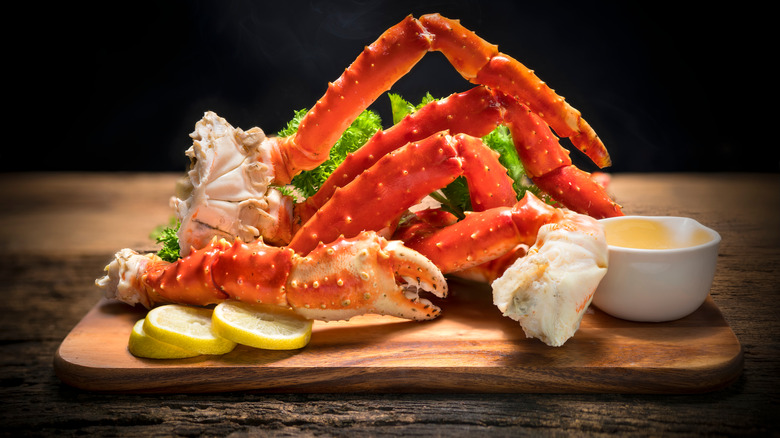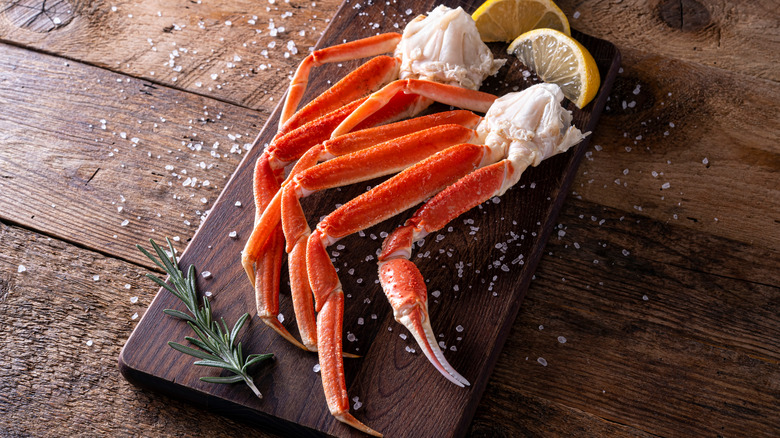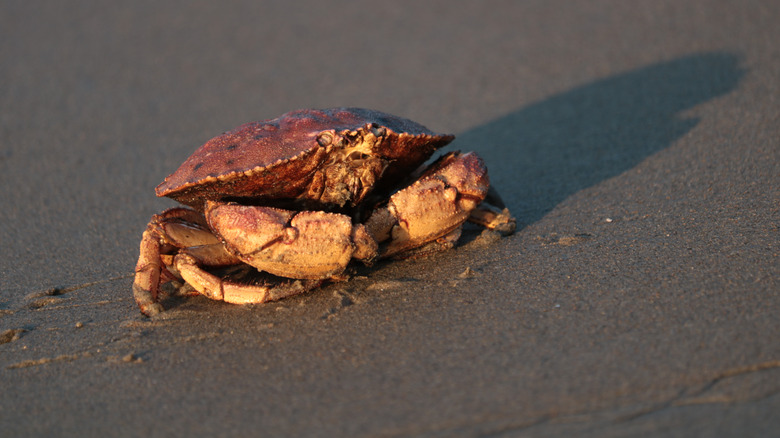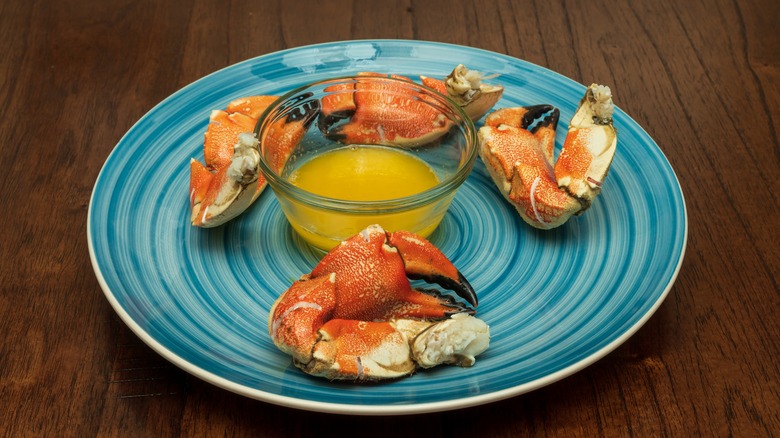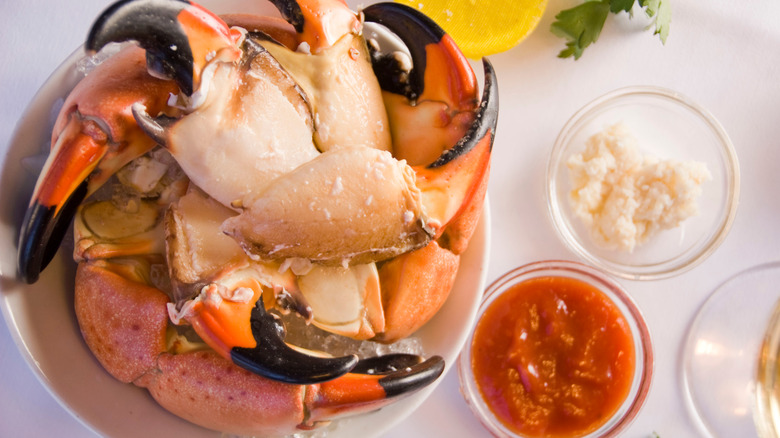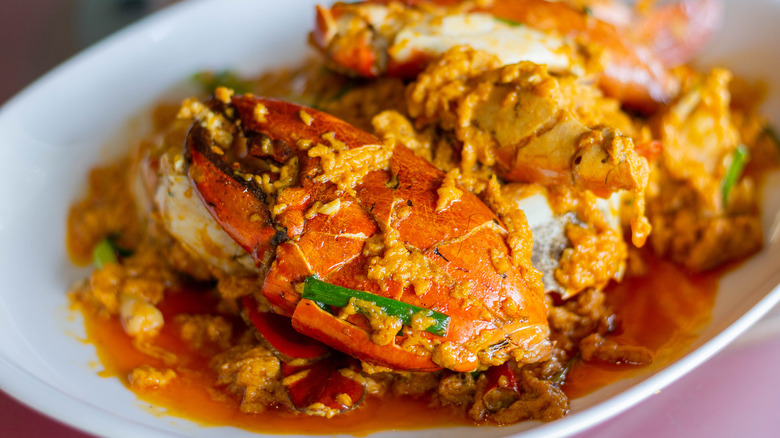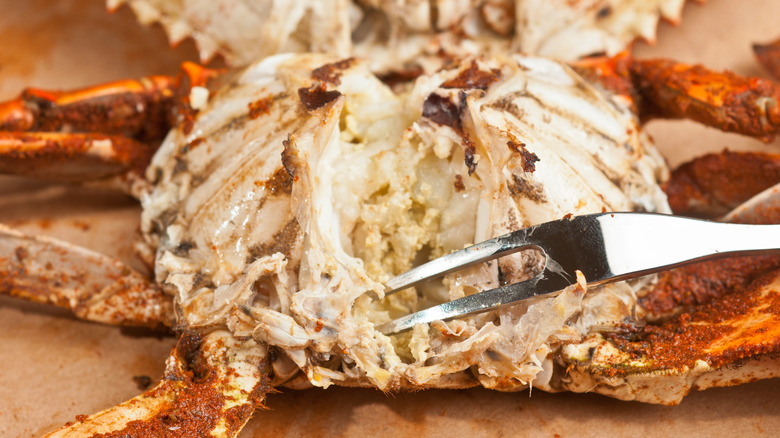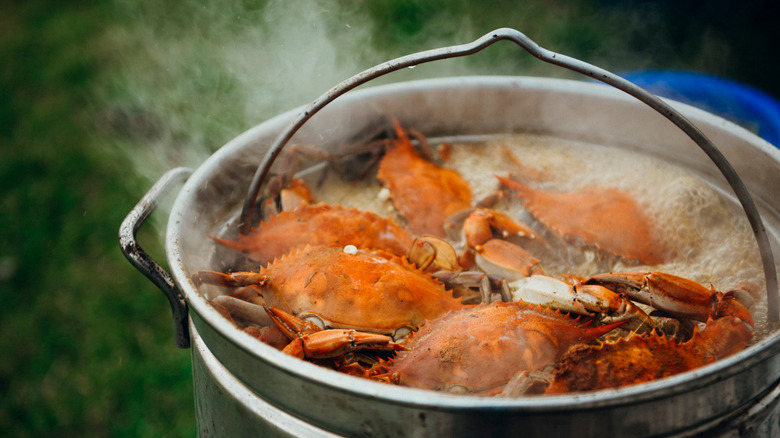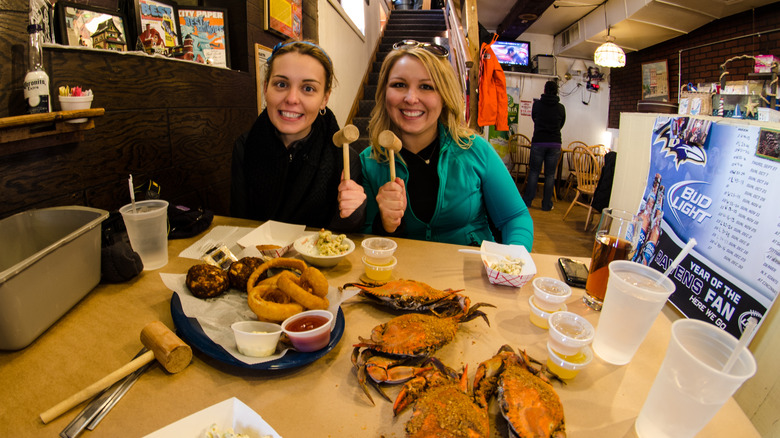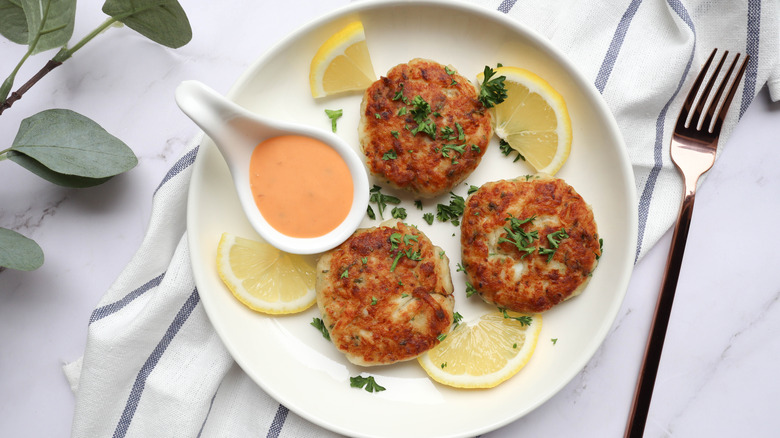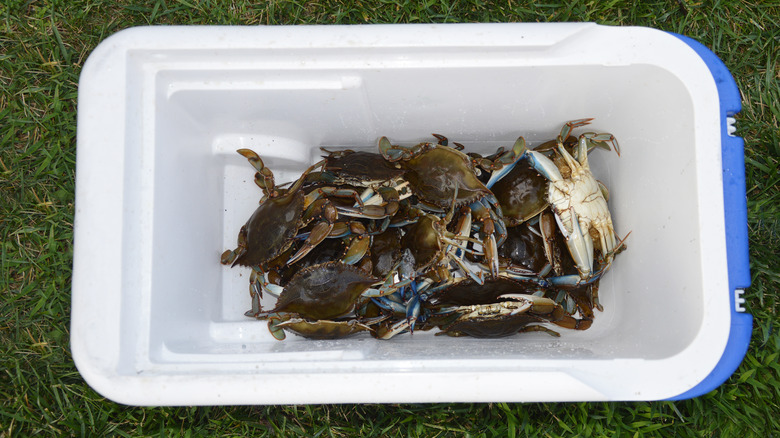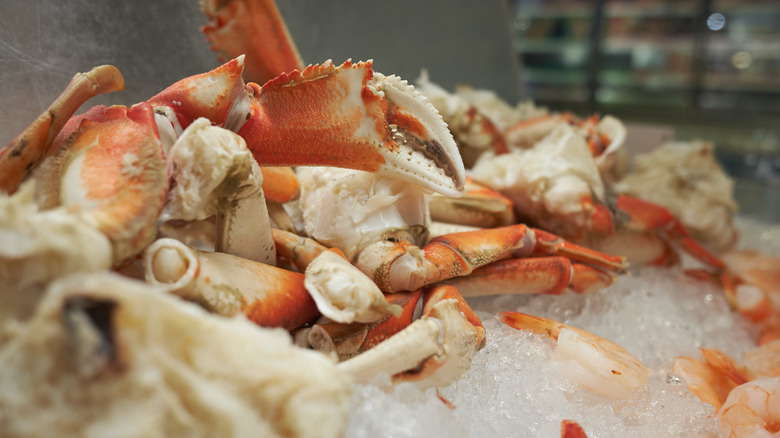Everything You Need To Know About Buying And Cooking Crabs
Sure there are fans of salmon and tuna out there, but crabs are one type of seafood that seems to inspire rabid devotion. Even causing devotees to drive across entire states to hit up a famous crab shack in Delaware (via Only in Your State). Put a fan in front of a platter of steamed blue crabs with a mallet and a crab cracker, and watch them enter a state of flow: smashing, cracking, extracting, and eating until there's nothing left except a pile of exoskeletons.
Perhaps crabs inspire such rabid devotion because there's a lot to know. So, you'd be forgiven if you're a little unfamiliar with the different types of crabs out there, like Dungeness, mud, or soft-shell crabs. Maybe you're unsure how to cook a live crab or clean it. We're here to help: Before you shop, peruse our guide to these luscious crustaceans to discover their availability, distinct qualities, and flavor — as well as how to buy and cook these seafood delicacies. We've also included a few handy recipes. Let's get cracking.
How to shop for crabs
If you are fortunate enough to have the chance to buy live crabs, you should absolutely take it, as live crabs are always superior to crabs that have been cooked and processed. According to Quality Seafood Delivery, you should never buy dead, raw crabs: They do not hold up well to cooking and can have an "off" flavor. Choose live crabs that appear to be lively and moving around in their tank. Healthy crabs not only taste great, but they are also more likely to stay alive until you are ready to cook them. Look for animals that feel heavy and have strong shells, according to the seafood site.
Quality Seafood also says you should also try to buy crabs that are in-season, as they tend to be higher quality and more affordable than out-of-season crabs. If you don't live near an ocean or can't buy in-season crabs, there are online crab vendors with good products. Look for vendors that guarantee fast turnover of their stock.
How much crab should you buy per person?
When trying to determine how many crabs you should buy, the first consideration is the types of crab. Potentially weighing up to four pounds, a single Dungeness crab can be a meal all on its own (via Leafy Place). By comparison, a single blue crab can yield only a few bite-sized morsels.
The second factor is size. Blue crabs can vary considerably in size and there is no established standard. As a general rule of thumb, blue crabs can range in size from "colossal" at 6 ½ inches or more in diameter, to "small," usually females 4 ½ to 5 inches in diameter (via Bluecrab.info). If you're buying crabs straight from the dock, No. 1 is the largest size, while No. 3 crabs are typically small females.
The size of the crab doesn't always directly relate to the amount of meat inside. In general, about 20 to 25 percent of a blue crab is edible meat, according to Crabbing Hub. Therefore, you can buy about 3 pounds of blue crab or about ⅔ to ¾ pounds of meat per person. Also, other types like the Alaskan king crab and snow crab are much meatier, says Crabbing Hub.
Finally, it's also important to consider the types of people who will be eating crabs. While children and newbie eaters may struggle to eat a lot of crab meat, experienced eaters can easily tear through a dozen crabs or more (via The Baltimore Sun).
Blue crab is synonymous with versatility
Easily recognized by their sapphire arms, NOAA Fisheries says blue crabs can be found along the Atlantic Coast, from Nova Scotia all the way down to Argentina. But, they are probably most associated with Maryland and the Chesapeake Bay. During that time frame, the availability and quality of blue crabs vary based on the crab's lifecycle. As blue crabs grow early in the season, they occasionally shed their existing hard shell and grow a new one, says NOAA Fisheries.
In the mid-Atlantic, Michelin says blue crabs are in season from April to December. While growing its new hard shell, a blue crab does not increase much in size, says Michelin. Once mature, which the food guide says happens to the mid-Atlantic population in the early fall, blue crabs no longer shed and become fuller. Michelin also says Maryland Blue Crabs are prized for their sweet flavor, which is caused by the crabs fattening themselves up as the Atlantic waters become cooler late in the season.
The meat of Blue Crabs is quite versatile, and it is used in everything from crab cakes to crab au gratin. Blue crabs are sold whole and the amount of meat per crab depends on size, with a typical yield of around 14%, according to the University of Florida. Blue Crabs are priced based on their size, and they can grow up to seven or eight inches in diameter, with females typically smaller (via National Wildlife Foundation).
Cook soft-shell crab whole
Soft-shell crabs are actually "hard-shell crabs" that are going through the molting process. Unlike humans, whose skin grows and stretches to accommodate growth, a crab's shell cannot stretch. The shell must therefore be replaced, or "molted," as the crab grows. Most soft-shell crabs are blue crabs scooped out of the ocean before their new shells have developed. Because crabs stop molting in cooler temperatures, soft shell crabs are available from spring to late summer.
While we tend to think of eating soft shell crabs whole, the gills abdomen mouth, and other inedible parts are all removed before cooking (via Crabbing Hub). Typical preparations include a soft shell crab being fried, grilled, boiled, broiled, steamed, or sautéed. Biting into a soft shell crab offers a number of different textures, and the flaky meat has a rich buttery sweetness.
Not being fully mature, soft shell blue crabs can range in size from about 3 ½ inches to more than 5 ½ inches (via Fulton Fish Market). However, the yield is significant because you eat pretty much the entire animal.
Dungeness crab is bigger and meatier
While the East Coast of the United States is strongly associated with blue crabs, the West Coast is known for Dungeness crabs. Bigger and meatier than their East Coast cousins, these crabs have many fans, including the late James Beard, who once said, "Dungeness crab is sheer unadulterated crab heaven," according to Eater.
Sea Grant California reports that the harvesting season is tightly regulated for Dungeness crabs, which runs from December to July in Northern California and November to late-June in Southern California. The Institute says Dungeness can be found in Alaska down to California and sometimes as far as Mexico. Being firm with sweet and nutty flavors, the meat from Dungeness crab is quite versatile and it can be found in anything from crab melts to crab bisques.
The typical Dungeness crab weighs approximately 2 pounds and yields about 25% of its weight, making it one of the most productive edible crabs (via Crabbing Hub). Dungeness crabs can be found whole or as picked meat, with prices lowest during the winter months when the harvest is at its peak (via Oregon Dungeness Crab Commission).
Alaskan king crab is delicate and sweet like lobster
Technically not a "true" crab, the Alaskan king crab falls under the Anomuran species rather than the Brachyura species to which true crabs belong, according to the Zoological Journal of the Linnean Society. That being said, the Alaskan Department of Fish and Game reports that three types are commercially-harvested: prickly looking golden, mild-flavored blue, and the popular red.
Found in Alaska, as well as Japan and the Aleutian Islands, the legal harvest season for Alaskan king crab is very short in order to maintain sustainability. Quality Seafood Delivery says Alaskan king crabs are sold as legs-only or whole using three different grades based on the number of legs that would comprise 10 pounds. For example, the retailer explains that a grade of 9/12 is given to a unit of jumbo Alaskan king crab with 9 to 12 legs or claws per 10 pounds — enough meat for a dinner party. King crab legs tend to be expensive because they are difficult to catch, ship, and have limited availability.
Alaskan king crab legs are prized for their smooth, delicate meat that has a pleasing sweetness and depth of flavor. Some compare the meat to that of premium lobster. The best preparations for Alaskan king crab legs are simple. Many of the best chefs in seafood restaurants steam the legs to cook the crab meat in its own juices. The legs are typically plated alongside aside of some lemon and a bowl of melted butter.
Snow crab is best for affordability
Snow crabs are known for their bright orange color and thick, meaty legs that are more than double the size of their body. These crabs are restaurant workhorses, probably because their relative affordability allows for a significant markup. Snow crabs live in cold, deep Arctic waters. Although it can be purchased throughout most of the year, availability depends on when the ice breaks apart in the Arctic Ocean, as fishing vessels must be able to navigate these waters to catch them.
Crabbing Hub says a fully grown snow crab weighs 5 to 7 pounds, and only clusters of crab legs are typically sold, which can yield about 30-to-35% meat, depending on the crab. This is a smaller yield than Alaskan king crabs but bigger than Dungeness or blue crabs.
Snow crab legs are often compared to Alaskan king crab legs, but snow crab is less prized due to its more fibrous meat. However, snow crab legs still deliver a delicious, sweet, and somewhat briny flavor. Snow crab legs are typically steamed, boiled, grilled, or baked. The whole legs are typically served with slices of lemon and a bowl of melted butter.
Peekytoe crab is a year-round New England delicacy
Also known as rock crab or Maine crab, this Peekytoe crab is native to New England waters but was an overlooked byproduct of lobster harvesting. Then, around 1997, Rod Mitchell of Browne Tradition Company in Portland, Maine, changed all that, putting the picked meat of these crustaceans on the market as "picked toe" crabs, due to their inward-facing back legs. Available year-round, this picked crab meat is coveted by chefs and favored for its silky, fine texture and delicate, refreshing flavor.
Peekytoe crab became prized for a delicate sweetness that lends itself to simple preparations. The New York Times reports the crab meat was successfully marketed to the restaurant industry and elevated by celebrity chefs at award-winning restaurants. At the Michelin-starred Le Bernardin in New York City, it was served between delicate pastry in a Napoleon, says The Times. But in Maine, it has been traditionally used in a crab meat version of a lobster roll, mixed with mayonnaise and other fillings served on a toasted hot dog bun.
Jonah crab is prized for its sizable claws
Found in Atlantic Ocean waters from Canada to Florida, NOAA Fisheries finds Jonah crabs were considered bycatch for many years by the lobster industry. However, the site says a decrease in the supply of New England lobsters and an increase in the prices of other crab species have made Jonah crabs more commercially attractive. They can now be bought year-round.
Mature Jonah crabs grow to around 6 or 7 inches in diameter and weigh between 12 and 20 ounces (via AZ Animals), but they are typically sold as either claw or picked meat. Restaurants will often serve the claws because they can be sizable, and the sweet meat has a desirably flaky texture. The meat often gets compared to that of Dungeness crabs, and Jonah crab meat is quite versatile. While it can shine in simple preparations, Jonah crab will also work well in crab cakes and other traditional crab recipes (via Alaskan King Crab Co.).
Stone crab is best boiled
Mostly associated with the Florida coast, Florida Fish and Wildlife Commission says stone crabs are known for their big, beefy claws with a distinct peachy pink color that fades into stark black tips. Flavor-wise, they're a cross between a blue crab and Maine lobster, a little richer than your average picked meat with a hint of the sea. Stone crab season in Florida runs from October 15 to May 1, says the commission.
Stone crabs are quite expensive and unique because only the claws are typically sold, and buying the whole animal isn't recommended. Claws must be at least 2.75 inches long in order to be sold and they are typically sold in four sizes: medium, large, jumbo, and colossal (via Florida Department of Agriculture and Consumer Services)
Cooked on crabbing boats, dockside, and in restaurants, stone crab claws are usually boiled to preserve the flavor and texture of the meat. The claws are then usually served in a style reminiscent of shrimp cocktail — pre-cracked and presented alongside cocktail sauce. The claws can also be steamed or baked, but these methods are less common than boiling. The crab meat is often used in standard recipes for chowders or salads.
Mud crab is ideal for strong spices
Hit up any seafood shack along Thailand's many beaches, and you'll find this mottled dark green, nearly black-hued creature steamed and coated in green chile powder for you to crack open and suck out the meat. Mud crabs are available year-round and popular around the Pacific and Indian oceans, including in Africa and Australia. These crabs, also called mangrove crabs or black crabs, are found stateside in oyster reefs, swamps, and marshes along the Atlantic coast, but this crab is more likely to be used as fishing bait than to wind up on your dinner plate (via Florida Sportsman).
Typically, mud crabs are around 7 inches in diameter and yielding about 25 percent of their body weight as edible meat, mud crabs have pleasing-yet-robust seafood flavor. Because of this, they stand up better to bolder preparations, particularly those featuring strong spices and aromatics. Popular ways to cook mud crab include steaming, boiling, stir-frying, pan frying, and poaching. Mud crab meat can also shine in dishes like risottos, crab cakes, and omelets.
How to clean crabs
Cleaning cooked crabs is a great way to help other people easily enjoy the meat. Cleaning is also necessary if you're looking to use fresh-cooked crab meat as an ingredient.
Andrew Zimmern starts by placing the crab down, bottom-side up. Then, you can pull off the triangular-shaped tail near the rear of the crab, which is also known as "the apron." Flip the crab over and pull off the shell, starting from the rear of the animal, says Zimmern. As you pull off the shell, tip forward to retain any liquid and "mustard" a fatty substance from the animal's back that's saved in the case of Dungeness crabs for use in a dipping sauce. After the liquid, and possibly the mustard, has been retained, Zimmern recommends removing the lungs, internal organs, and mandibles. He says the crab can then be rinsed clean or not, if you want to retain more flavor.
Since soft-shell crabs are eaten whole, they require a different cleaning process. Southern Living recommends starting by using a sharp pair of kitchen shears to make a ½-inch incision that passes through the mouth and eyes to humanely kill the crab. Southern Living then says to squeeze out and discard any material produced by the incision, then carefully raise the top shell of the crab and use shears to remove the feathery gills on each side. Turn the crab over and use shears to remove the apron. Rinse the crab again before storing or cooking.
How to cook crabs
You may want to think twice before you boil crab, steam crab, or grill crab. The traditional way is to cook them alive, but research has shown this is likely inhumane. According to the Royal Society for the Prevention of Cruelty to Animals, crabs can be humanely killed by chilling them, then driving a sharp knife into the crab's nerve center. After spiking your crabs, place them in the pan with the grill rack, top with pats of butter, add the seafood seasoning blend of your choice, and grill for around 30 minutes.
Boiling crabs is probably the most common way to cook them, and many people use a Cajun crab boil recipe. Our recommended recipe calls for boiling small red potatoes, corn on the cob, crab, other seafood, sausage, and Cajun crab boil seasoning in a large pot. Steaming is what makes a Chesapeake Bay-style crab fest so unique. Our recommended approach to cooking crabs this way calls for steaming them in a basket over a blend of water, beer, and a bit of Old Bay seasoning. Crabs can also be cooked with a backyard grill and a rectangular pan with a fitted grill rack (via Southern Coastal Cooking).
Another way to prepare crab is to roast it in the oven with Asian spices. Edible San Francisco says to add cooked, cleaned, and chopped Dungeness crab to a roasting pan with sambal, butter, oil, herbs, and aromatics, then roast for 20 minutes at 400 F.
How to eat crabs
While it's possible to eat whole crabs or crab legs without any special tools, your hands will only get you so far. Even experienced crab eaters don't go in without at least using a crab cracker (via The Washington Post). Expert crab eaters also know it's a good idea to lay down some butcher paper or newspaper before getting started.
For whole crabs, Real Simple recommends starting by taking off the small triangular tail-like piece of exoskeleton on the bottom rear of the crab, called the apron, before pulling the top of the crab's shell off by starting at the rear. Once the crab's innards are exposed, you can remove them with your hands, as they are not pleasant to eat. For smaller crabs, Real Simple recommends break them in half widthwise with your hands: For each half, squeeze down on the bottom membrane shell and peel it back to expose and remove the leg meat. Use a mallet to crack each claw and pull out the meat.
Dungeness and larger crabs can be cracked in half and either quartered with a knife or the legs cut into lollipops (via Andrew Zimmern). To expose more meat, the claws can be broken apart at the joints and cut open lengthwise with scissors.
Experiment with crab meat recipes
Eating crab meat right out of the shell is a great way to enjoy it, but it's not the only way. Crab cakes, crab pasta salad, crab ravioli, and crab chowder are all dishes that showcase this unique meat.
One crab cake recipe that everyone will love includes Dijon mustard, Old Bay seasoning, and ground buttery crackers. Before starting, be sure to double- and triple-check your crab meat for bits of shell that must be removed. Showcase crab meat in a creamy crab pasta salad recipe that includes black olives, sun-dried tomatoes, and red onion. This recipe is a great one to make ahead of an outdoor, warm-weather party.
There are plenty of good options out there when it comes to a crab ravioli recipe, but one of our favorites has parsley, lemon, and ricotta in the meat filling. If you aren't an experienced pasta maker, this recipe is a great way to get some practice in, and you can always eat any suboptimal results. You don't have to be from New England to make great chow-dah. All you need is a good crab and corn chowder recipe. The flavor combination of crab and corn is a natural one, and making chowder is about as easy as it gets.
How to store live crabs
Whether you are getting crabs straight from the boat or from your local supermarket, the best thing to do is to cook them right away. But, understandably, there will be times when you need to store live crabs until you are able to cook them, and there are a couple of ways in which you can safely preserve them.
The best and most convenient way to store live crabs is to keep them in a chilled cooler. Crabbing Hub says you should ideally use a large cooler with a drainage spigot because crabs do not keep well in standing water. First, the site says to line the bottom with a thin layer of ice or small ice packs, and cover the ice layer with a towel to keep your crabs from freezing. After adding the crabs, be sure to leave the lid cracked open slightly to provide a bit of ventilation.
If you don't have a cooler handy, Crabbing Hub also recommends storing them in a bushel basket: Stack the crabs as best you can in the bushel basket and cover them with a wet towel, damp newspaper, or seaweed. This approach to storage is more of a temporary solution than using a cooler. You can prolong the lives of your crabs by keeping the basket out of the sun.
How to store cooked crabs
After crabs have been boiled or steamed, they can be stored in a refrigerator for several days. Crabbing Hub recommends simply tossing them in a container and leave them in a refrigerator set to around 40 degrees. According to Crabbing Hub, whole crabs can be stored in a refrigerator for five to seven days, but they tend to lose their flavor in about three. If stored crab starts to have funky aromas or flavors, it's likely gone bad. If you plan on keeping whole cooked crabs refrigerated for more than three days, cleaning them before storage can help to prolong their shelf life, says the site.
If you need to store cooked crabs for longer than a week, freezing them is an option. However, you should clean the crabs before placing them in a freezer. Placing crabs in a sealed bag or Tupperware container will help to prevent freezer burn. Cooked crabs can last up to six months in a freezer, possibly longer, says Crabbing Hub. If your thawed crab has "off" aromas or flavors, it's not safe to eat.
